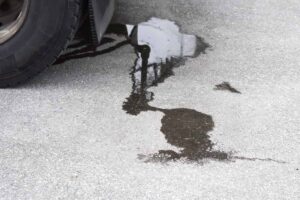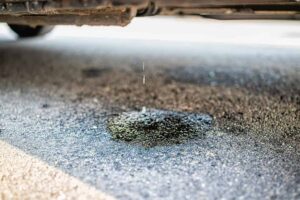Noticing water leaking from your car can be worrying—but it’s not always a bad sign. In many cases, a small puddle under your vehicle is completely normal, especially after running the air conditioner.
That said, there are times when water leaks could point to a blocked drain, a faulty seal, or something more serious. In this blog, we’ll break down the common reasons cars leak water, how to tell if it’s a problem, and when it’s time to have your car checked by a professional.
Common Causes of Water Leaking from Your Car
If you’ve noticed a clear puddle under your car, there’s a good chance it’s water—and not something more serious like coolant or oil. Here are a few of the most common and harmless reasons your car might be leaking water:
Air Conditioning Condensation
When you run your car’s air conditioning, condensation naturally forms as part of the cooling process. This water usually drains underneath the car on the passenger side and is completely normal. If you see a small puddle after using the A/C—especially on warmer days—there’s likely nothing to worry about.
Exhaust Condensation
Another common source of water is your car’s exhaust system. When your engine burns fuel, it produces water vapour, which can condense and drip from the exhaust pipe—particularly during cold starts. This is usually most noticeable in cooler weather and should stop once the engine warms up.
Windshield Washer System Leaks
Sometimes, a leak that looks like water may be coming from your windshield washer reservoir or lines. If the fluid isn’t coloured or doesn’t have a strong scent, it may still be washer fluid that’s leaked due to a crack or loose hose. A quick visual inspection can often confirm this.
When a Water Leak Could Be a Problem
While many water leaks are harmless, there are times when moisture under your car could be a sign of a deeper issue. Here’s when you should pay closer attention:
Blocked Air Conditioning Drain
Your car’s A/C system is designed to release condensation through a small drain tube. If this tube becomes blocked, the water can back up and leak into the cabin—often soaking the passenger-side carpet. This can lead to mould, unpleasant smells, and electrical damage if not addressed quickly.
Sunroof or Door Seal Leaks
If water is getting inside your car during or after rain, it could be due to worn or damaged weather seals around the doors, windows, or sunroof. These seals are meant to keep moisture out, but over time they can crack, shrink, or become misaligned—leading to leaks that can damage interior trims, electronics, and upholstery.
If you suspect your car’s water leak isn’t just A/C or exhaust condensation, it’s best to have it inspected before it causes further damage.
Is It Really Water? (Or Something Else?)
Before assuming that the puddle under your car is water, it’s important to rule out other automotive fluids. While water is usually clear and odourless, other leaks can look similar at first glance but signal serious mechanical issues.
Here’s how to tell the difference:
-
Coolant (Antifreeze): Typically green, orange, or pink in colour and has a sweet smell. If you spot a colourful puddle, it’s likely coolant—this requires immediate attention.
-
Engine Oil: Usually brown or black, and has a slick, greasy texture. Oil leaks often appear under the engine bay.
-
Brake Fluid: Pale yellow when fresh, darker as it ages. It’s slippery and typically found near the wheels or under the brake master cylinder.
-
Transmission Fluid: Reddish or pink when new, darker brown as it ages. Often found under the centre of the car.
-
Washer Fluid: Can be blue, green, or clear, depending on the brand. While not dangerous, it may indicate a loose or cracked line.
If you’re unsure whether the leak is water or something else, it’s always best to have a professional take a look. Catching issues early can prevent expensive repairs later on.
Preventative Tips to Avoid Leaks
While some water leaks—like A/C condensation—are normal, others can be prevented with simple maintenance. Here are a few tips to help keep your car leak-free:
-
Clear Out Drain Channels Regularly
Check and clear debris from sunroof, door, and A/C drain channels to prevent blockages that can cause water to back up into the car. -
Inspect Seals and Weather Stripping
Look for cracks, gaps, or signs of wear around windows, doors, and the sunroof. Replacing worn-out seals can help keep moisture out. -
Service Your A/C System Annually
Having your air conditioning checked during regular car servicing helps ensure the drain line is clear and working properly. -
Keep an Eye on Interior Moisture
If you notice damp carpets or foggy windows, check for leaks immediately before mould or electrical damage sets in. -
Park Smart
Avoid parking under trees or in areas where leaves and debris can build up around drains and seals.
Preventative care not only helps avoid leaks—it also extends the life of your car’s components and keeps your cabin clean and dry.
In a Nutshell
Seeing water under your car isn’t always a cause for alarm—especially if it’s just condensation from your air conditioning or exhaust. But if the leak seems excessive, appears inside the cabin, or you’re unsure whether it’s actually water, it’s worth getting it checked.
At Rossi Mechanical, we’re here to help diagnose the source of any leak and get your car back in top shape. If you’re concerned about water leaking from your vehicle, book a diagnostic check with our expert team today and drive with confidence.




